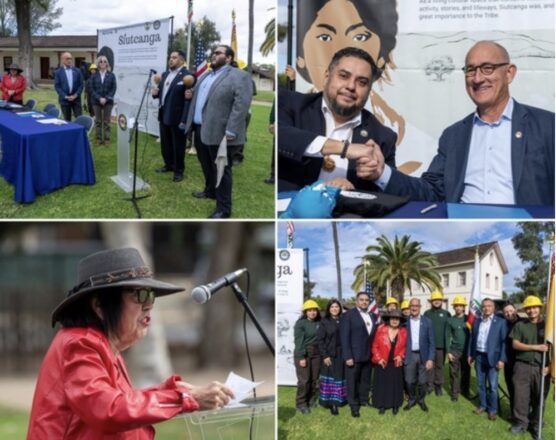California State Parks and the Fernandeño Tataviam Band of Mission Indians (Tribe) signed a historic agreement Thursday to formalize their cooperation and collaboration in the management and protection of natural and cultural resources and interpretation for state parks within the Tribe’s ancestral lands. They will collaborate on interpretation at the state parks, including for the Village of Siutcanga, incorporate traditional ecological knowledge into the management of natural resources, and cooperate on the protection of the landscapes.
The signing of the memorandum of understanding (MOU) took place Wednesday, Nov. 29, at Siutcanga, the “place of the oaks,” now known as Los Encinos SHP in Encino, California. The park is a significant Tribal cultural area with over 70% of citizens descending from the village. The Tribe is a native sovereign nation of northern Los Angeles County composed of a coalition of lineages originating in the Santa Clarita, Simi, San Fernando and Antelope valleys.

Representatives of the Fernandeño Tataviam Band of Mission Indians and State Parks staff. Photos from California State Parks.
Below are the statements made by the Tribe and California State Parks Director:
Rudy Ortega Jr., Tribe president and descendant of Siutcanga (Los Encinos State Historic Park): “180 years ago, my great grandmother stood here defending this village from settlers. Fifty years ago, my father stood here defending our cultural resources from a construction project. For the first time since colonization, I stand here in celebration of a monumental moment: an agreement that sees us as a Tribal government, but more importantly, as People.”
Beverly Folkes, vice chair, council of elders, Fernandeño Tataviam Band of Mission Indians: “We are filled with joy for this collaboration with our California State Parks partners that coordinates access to state lands for our ceremonies, medicine plant gathering, and recreation. When you spend time on land that is undisturbed by development and where our ancestors once lived, you feel their presence and a sense of freedom. Los Encinos in particular, the land where my grandfather and great grandmother lived is of special importance to me as I feel closer to my relatives knowing I’m walking on land where my ancestors once stepped.”
Armando Quintero, State Parks Director–“California’s state parks are places that protect not only the incredible landscapes of California but serve as a reminder of the deep human history of these lands stretching into time immemorial. The rich and diverse cultures of the earliest ancestors of these lands are alive today in the cultures, traditions, and languages of the Fernandeño Tataviam people. Today, we celebrate the history and the future of the Fernandeño Tataviam Band of Mission Indians Tribe with the signing of this MOU. We live in a California where we should all thrive.”
This is the 10th MOU State Parks has with a California Native American Tribe. The department’s Tribal MOU program seeks to facilitate collaboration between California Native American tribes and State Parks by establishing protocols for continuous open discussions and outlining the responsibilities of each party to promote successful cooperation and partnership. To learn more about the program, please visit parks.ca.gov/TribalMOUProgram.
About the Fernandeño Tataviam Band of Mission Indians
The Fernandeño Tataviam Band of Mission Indians is a native sovereign nation of northern Los Angeles County composed of a coalition of lineages originating in the Santa Clarita, Simi, San Fernando, and Antelope valleys. Today, the Tribal Administration Office is in San Fernando, CA. FTBMI was originally recognized in 1892, when a Special Assistant U.S. Attorney recommended that the federal government take action for Fernandeño land rights under the Mission Indian Relief Act of 1891. For more information, visit the FTBMI’s website.
The California Department of Parks and Recreation, popularly known as State Parks, and the programs supported by its Office of Historic Preservation and divisions of Boating and Waterways and Off-Highway Motor Vehicle Recreation provide for the health, inspiration and education of the people of California by helping to preserve the state’s extraordinary biological diversity, protecting its most valued natural and cultural resources, and creating opportunities for high-quality outdoor recreation. Learn more at parks.ca.gov.
Like this:
Like Loading...
Related





 Tweet This
Tweet This Facebook
Facebook Digg This
Digg This Bookmark
Bookmark Stumble
Stumble RSS
RSS



























REAL NAMES ONLY: All posters must use their real individual or business name. This applies equally to Twitter account holders who use a nickname.
0 Comments
You can be the first one to leave a comment.